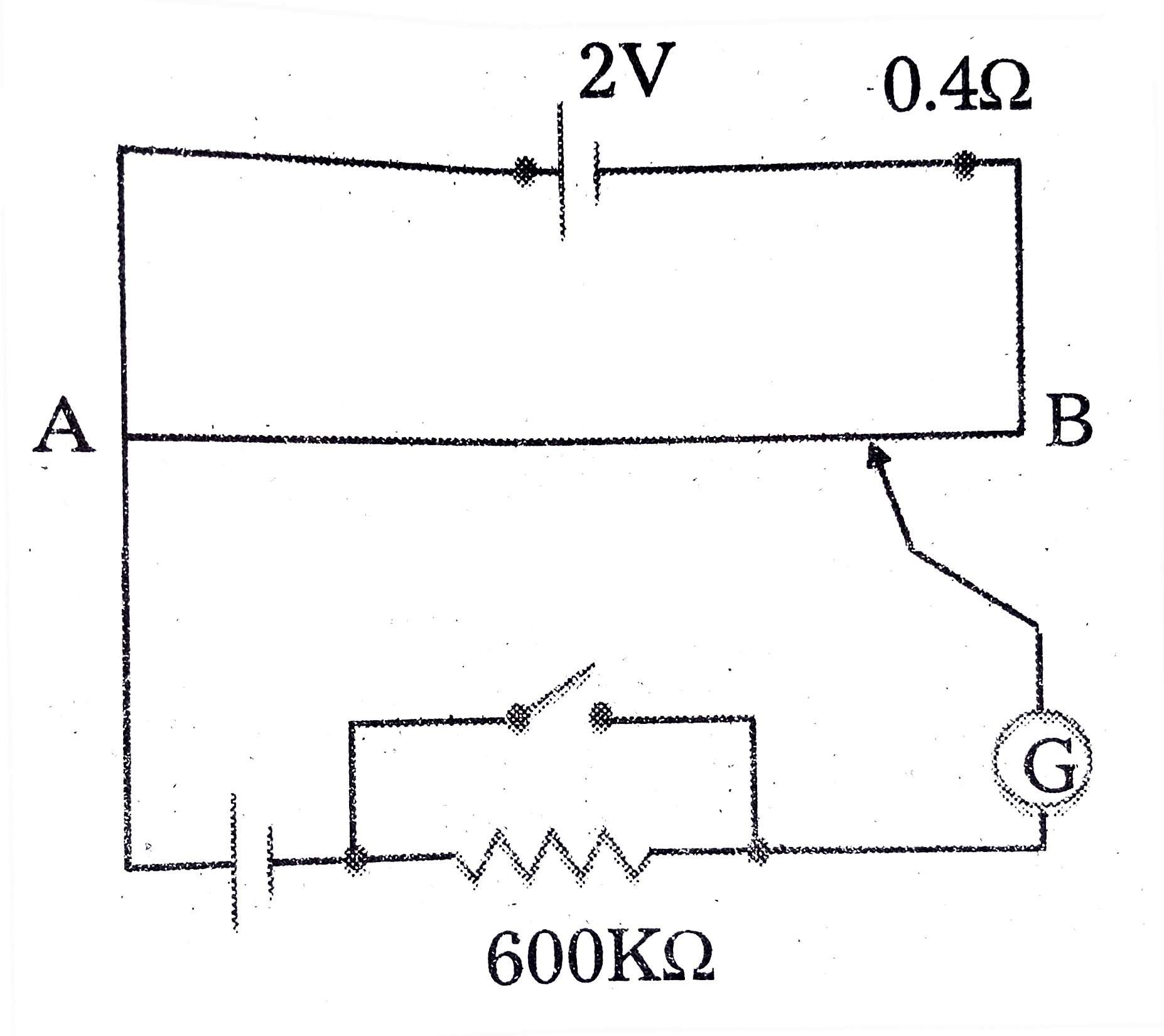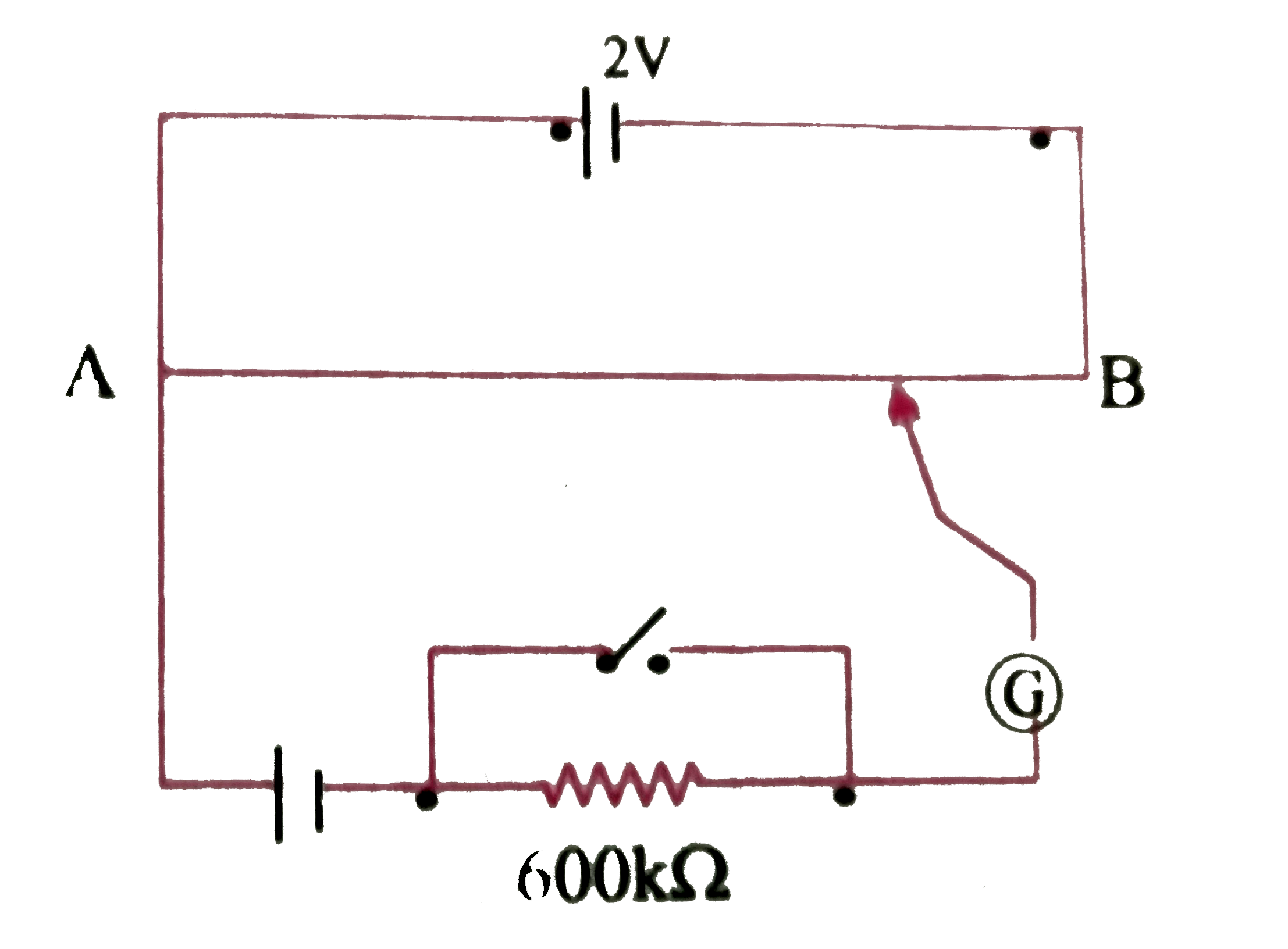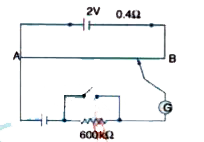Shows a potentiometer with a cell of 2.0 V and internal resiatance 0.40Ω maintaining a potential drop across the reistor wire AB . A standard cell which maintain a constant emf of 1.02 V (for very moderate currents up to a few mA ) gives a balance point at 67.3 cm length of the wire . To ensure very low currents from the standard cell , a very high resistance of 600kΩ is put in series with it , whcich is horrted close t the balance point . The standard cell is then replaced by a cell of unknown emf e and the balance ponit found similarly , turns out to to be at 82.3 cm length of the wire .

Is the balance ponit affected by the internal reistance of the driver cell ?
The internal resistance of the driver cell has no influence on the balance point .
Topper's Solved these Questions
- KIRCHHOFF'S LAWS AND ELECTRICAL MEASUREMENT BOOK - CHHAYA PUBLICATIONCHAPTER - KIRCHHOFF'S LAWS AND ELECTRICAL MEASUREMENT EXERCISE - NCERT EXEMPLAR QUESTIONS WITH ANSWER HINT (MCQ -1)
2 Videos
- KIRCHHOFF'S LAWS AND ELECTRICAL MEASUREMENT BOOK - CHHAYA PUBLICATIONCHAPTER - KIRCHHOFF'S LAWS AND ELECTRICAL MEASUREMENT EXERCISE - NCERT EXEMPLAR QUESTIONS WITH ANSWER HINT (MCQ -2)
1 Videos
- KIRCHHOFF'S LAWS AND ELECTRICAL MEASUREMENT BOOK - CHHAYA PUBLICATIONCHAPTER - KIRCHHOFF'S LAWS AND ELECTRICAL MEASUREMENT EXERCISE - HIGHER ORDER THINKING SKILL (HOTS) QUESTIONS
20 Videos
- ELEMENTARY PHENOMENA OF ELECTROSTATICS BOOK - CHHAYA PUBLICATIONCHAPTER - ELEMENTARY PHENOMENA OF ELECTROSTATICS EXERCISE - EXAMINATION ARCHIVE
2 Videos
- LIGHT WAVE AND INTERFERENCE OF LIGHT BOOK - CHHAYA PUBLICATIONCHAPTER - LIGHT WAVE AND INTERFERENCE OF LIGHT EXERCISE - CBSE SCANNER
15 Videos
Similar Questions
A student chooses the stancdard resistance S to be 100Ω while measuring a resistance R by using a metre bridge He finds the null point at l1=2.9 cm . He is told to attempt to improve accuracy . Which of the following is a useful way ?
View SolutionKirchhoff's junction rule is a reflection of
View SolutionWhat is the potential at the point O of the circuit shown in the ?

View SolutionDefine surface density of electric charge
View SolutionIn Young's double slit experiment derive the condition for (i) constructive interference and (ii) destructive interference at a point on the screen.
View SolutionFigure shows a potentiometer with a cell of 2.0 V and internal resistance 0.40Ω maintain a potential drop across the resistor wire AB. A standard cell which maintains a constant emf of 1.02 V (for very moderate currents upto a few mA) gives a balances point at 63.3 cm length of the wire. To ensure very low currents drawn from the standard cell, a very high resistance of 600Ω is put is series with it, which is shortedd close to the balance point. The standard cell is then replaced by a cell of unknown emf ε and the balance point found similarly, turns out to be at 82.3 cm length of the wire.

What is the value ε ?
View SolutionFigure shows a potentiometer with a cell of 2.0 V and internal resistance 0.40Ω maintain a potential drop across the resistor wire AB. A standard cell which maintains a constant emf of 1.02 V (for very moderate currents upto a few mA) gives a balances point at 63.3 cm length of the wire. To ensure very low currents drawn from the standard cell, a very high resistance of 600Ω is put is series with it, which is shortedd close to the balance point. The standard cell is then replaced by a cell of unknown emf ε and the balance point found similarly, turns out to be at 82.3 cm length of the wire.

Is the balance point affected by this high resistance?
View SolutionFigure shows a potentiometer with a cell of 2.0 V and internal resistance 0.40 Omega maintain a potential drop across the resistor wire AB. A standard cell which maintains a constant emf of 1.02 V (for very moderate currents upto a few mA) gives a balances point at 63.3 cm length of the wire. To ensure very low currents drawn from the standard cell, a very high resistance of 600 Omega is put is series with it, which is shortedd close to the balance point. The standard cell is then replaced by a cell of unknown emf epsilon and the balance point found similarly, turns out to be at 82.3 cm length of the wire. Is the balance point affected by the internal resistance of the driver cell.
View SolutionFigure shows a potentiometer with a cell of 2.0 V and internal resistance 0.40Ω maintain a potential drop across the resistor wire AB. A standard cell which maintains a constant emf of 1.02 V (for very moderate currents upto a few mA) gives a balances point at 63.3 cm length of the wire. To ensure very low currents drawn from the standard cell, a very high resistance of 600Ω is put is series with it, which is shortedd close to the balance point. The standard cell is then replaced by a cell of unknown emf ε and the balance point found similarly, turns out to be at 82.3 cm length of the wire.

Would the method work in the above situation if the driver cell of the potentiometer had an emf of 1.0 V instead of 2.0 V?
View SolutionFigure shows a potentiometer with a cell of 2.0 V and internal resistance 0.40 Omega maintain a potential drop across the resistor wire AB. A standard cell which maintains a constant emf of 1.02 V (for very moderate currents upto a few mA) gives a balances point at 63.3 cm length of the wire. To ensure very low currents drawn from the standard cell, a very high resistance of 600 Omega is put is series with it, which is shortedd close to the balance point. The standard cell is then replaced by a cell of unknown emf epsilon and the balance point found similarly, turns out to be at 82.3 cm length of the wire. Would the circuit work well for determining an extermely small emf, say of the order of a few mV (such as the typcial emf a thermo-couple)? if not, how will you modify the circuit?
View Solutionचित्र में एक वोल्ट्मीटर दर्शाए गया है जिसमे एक 2.0V और आंतरिक प्रतिरोध 0.40Ω का कोई सेल वोल्ट्मीटर के प्रतिरोधक तार AB पर वोलटता पात बनाये रखता है । कोई मानक सेल जो 1.02 V का अचर विद्युत वाहक बल बनये रखता है ( कुछ mA की बहुत सामान्य धाराओं के लिए ) तार की 67.3 सेमी लम्बाई पर संतुलन बिंदु देती है । मानक सेल से अति न्यून धारा लेना सुनिश्चित करने के लिए इसके साथ परिपथ में श्रेणी 600kΩ का एक अति उच्च प्रतिरोध इसके साथ संबद्ध किया जाता है , जिसके संतुलन बिंदु प्राप्त होने के निकट लघुपथित (Shorted) कर दिया जाता है । इसके बाद मानक सेल को किसी अज्ञात विद्युत बल के सेल को किसी अज्ञात विद्युत वाहक बल के सेल से प्रतिस्थापित कर दिया जाता है । जिससे संतुलन बिंदु तार की 82.3 सेमी लम्बाई पर प्राप्त होता है ।
(a) ε का मान क्या है ?

View Solutionचित्र में एक वोल्ट्मीटर दर्शाए गया है जिसमे एक 2.0V और आंतरिक प्रतिरोध 0.40Ω का कोई सेल वोल्ट्मीटर के प्रतिरोधक तार AB पर वोलटता पात बनाये रखता है । कोई मानक सेल जो 1.02 V का अचर विद्युत वाहक बल बनये रखता है ( कुछ mA की बहुत सामान्य धाराओं के लिए ) तार की 67.3 सेमी लम्बाई पर संतुलन बिंदु देती है । मानक सेल से अति न्यून धारा लेना सुनिश्चित करने के लिए इसके साथ परिपथ में श्रेणी 600kΩ का एक अति उच्च प्रतिरोध इसके साथ संबद्ध किया जाता है , जिसके संतुलन बिंदु प्राप्त होने के निकट लघुपथित (Shorted) कर दिया जाता है । इसके बाद मानक सेल को किसी अज्ञात विद्युत बल के सेल से प्रतिस्थापित कर दिया जाता है । जिससे संतुलन बिंदु तार की 82.3 सेमी लम्बाई पर प्राप्त होता है ।
(d ) क्या संतुलन बिंदु चालक के सेल के आंतरिक प्रतिरोध से प्रभावित होता है ?

View SolutionFigure shows a potentiometer with a cell of 2.0 V and internal resistance 0.40 Omega maintaining a potential drop across the resistor wire AB. A standard cell which maintains a constant emf of 1.02 V (for every moderate currents upto a few mA) gives a balance point at 67.3 cm length of the wire. To ensure very low currents drawn from the standard cell, a very high resistance of 600 Omega is put in series with it, which is shorted close to the balance point. The standard cell is then replaced by a cell of unknown emf epsi and the balance point found similarly, turns out to be at 82.3 cm length of the wire. What is the value epsi ?
View SolutionFigure shows a potentiometer with a cell of 2.0 V and internal resistance 0.40 Omega maintaining a potential drop across the resistor wire AB. A standard cell which maintains a constant emf of 1.02 V (for every moderate currents upto a few mA) gives a balance point at 67.3 cm length of the wire. To ensure very low currents drawn from the standard cell, a very high resistance of 600 Omega is put in series with it, which is shorted close to the balance point. The standard cell is then replaced by a cell of unknown emf epsi and the balance point found similarly, turns out to be at 82.3 cm length of the wire. Would the method work in the above situation if the driver cell of the potentiometer had an emf of 1.0 V instead of 2.0 V?
View SolutionFigure shows a potentiometer with a cell of 2.0 V and internal resistance 0.40 Ω maintaining a potential drop across the resistor wire AB. A standard cell which maintains a constant emf of 1.02 V (for every moderate currents upto a few mA) gives a balance point at 67.3 cm length of the wire. To ensure very low currents drawn from the standard cell, a very high resistance of 600 Ω is put in series with it, which is shorted close to the balance point. The standard cell is then replaced by a cell of unknown emf ε and the balance point found similarly, turns out to be at 82.3 cm length of the wire.

Would the circuit work well for determining an extremely small emf, say of the order of a few mV (such as the typical emf of a thermo-couple)? If not, how will you modify the circuit?
View SolutionFig. shows a potentiometer with a cell of 2.0V and internal resistance 0.40Omega maintaining a potential drop across the resistor wire AB. A standard cell which maintains a constant emf of 1.02V (for very moderate currents upto a few pA) gives a balance point at 67.3 cm length of the wire. Io ensure very low currents drawn from the standard cell, a very high resistance of 600kOmega is put in series with it which is shorted close to the balance point. The standard cell is then, replaced by a cell of unknown emf e and the balance point found similarly turns out to be at 82.3 cm length of the wire, What purpose does the high resistance of 600kOmega have?
View Solution
